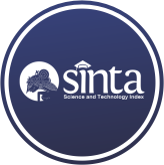Analisis Pengaruh Komposisi Data Training dan Testing Terhadap Akurasi Algoritma Resilient Backpropagation (RProp)
(1) STIKOM Tunas Bangsa Pematangsiantar, Indonesia
(2) STIKOM Tunas Bangsa Pematangsiantar, Indonesia
(*) Corresponding Author
Abstract
Full Text:
PDFReferences
H. Okprana, M. R. Lubis, and J. T. Hadinata, “Prediksi Kelulusan TOEFL Menggunakan Metode Resilient Backpropagation,” J. Edukasi dan Penelit. Inform., vol. 6, no. 2, p. 275, 2020, doi: 10.26418/jp.v6i2.41224.
S. P. Sinaga et al., “Implementasi Jaringan Syaraf Tiruan Resilient Backpropagation dalam Memprediksi Angka Harapan Hidup Masyarakat Sumatera Utara,” J. Infomedia, vol. 4, no. 2, 2019.
W. Saputra, J. T. Hardinata, and A. Wanto, “Implementation of Resilient Methods to Predict Open Unemployment in Indonesia According to Higher Education Completed,” J. Inf. Technol. Educ. Res., vol. 3, no. 1, pp. 163–174, 2019, doi: 10.31289/JITE.V3I1.2704.
B. Poerwanto and F. Fajriani, “Resilient Backpropagation Neural Network on Prediction of Poverty Levels in South Sulawesi,” MATRIK J. Manajemen, Tek. Inform. dan Rekayasa Komput., vol. 20, no. 1, pp. 11–18, 2020, doi: 10.30812/matrik.v20i1.726.
W. Saputra, J. T. Hardinata, and A. Wanto, “Penerapan Metode Resilient dalam Menentukan Model Arsitektur Terbaik untuk Prediksi Pengangguran Terbuka di Indonesia,” Semin. Nas. Apl. Teknol. Inf., pp. 21–29, 2019.
Y. Yusran, “Implementasi Jaringan Syaraf Tiruan (Jst) Untuk Memprediksi Hasil Nilai Un Menggunakan Metode Backpropagation,” J. Ipteks Terap., vol. 9, no. 4, pp. 269–275, 2016, doi: 10.22216/jit.2015.v9i4.571.
I. N. T. Adnyana, I. G. P. S. Wijaya, and M. A. Albar, “Jaringan Syaraf Tiruan Model Backpropagation untuk Peramalan Suhu Minimum dan Maksimum, Kelembaban, Tekanan Udara, Jumlah Hari Hujan, dan Curah Hujan Bulanan di Kota Mataram,” J. Comput. Sci. Informatics Eng., vol. 3, no. 2, 2019, doi: 10.29303/jcosine.v3i2.259.
S. R. Jannah, F. Fithria, S. Novitayani, C. Husna, and J. Juanita, “Upaya Peningkatan Kelulusan TOEFL Mahasiswa dengan Metode Self Help Group (SHG),” Idea Nurs. J., vol. 10, no. 1, pp. 44–50, 2019, doi: doi.org/10.52199/inj.v10i1.16549.
I. Irmayani and A. M. Sudirman, “Implementasi Aplikasi Tes TOEFL Berbasis Desktop,” Pros. Semant., vol. 2, no. 1, pp. 169–174, 2019, [Online]. Available: https://journal.uncp.ac.id/index.php/semantik/article/view/1505/1313
Agus Perdana Windarto, “Implementasi Jst Dalam Menentukan Kelayakan Nasabah Pinjaman Kur Pada Bank Mandiri Mikro Serbelawan Dengan Metode Backpropogation,” J-SAKTI (Jurnal Sains Komput. dan Inform., vol. 1, no. 1, pp. 12–23, 2017, doi: 10.7910/DVN/BRQ1OX.
S. Solikhun, M. Safii, and A. Trisno, “Jaringan Saraf Tiruan Untuk Memprediksi Tingkat Pemahaman Sisiwa Terhadap Matapelajaran Dengan Menggunakan Algoritma Backpropagation,” J-SAKTI (Jurnal Sains Komput. dan Inform., vol. 1, no. 1, p. 24, 2017, doi: 10.30645/j-sakti.v1i1.26.
R. Prasetya, “Implementasi Jaringan Syaraf Tiruan Backpropagation untuk Memprediksi Ketinggian Air (Studi Kasus: Sungai Ciliwung),” STRING (Satuan Tulisan Ris. dan Inov. Teknol., vol. 1, no. 3, p. 297, 2017, doi: 10.30998/string.v1i3.1558.
“View of Komparasi Algoritma Machine Learning untuk Penentuan Performance Terbaik Pada Prediksi Produksi Tanaman Jahe di Indonesia.” https://www.prosiding.politeknikcendana.ac.id/index.php/sanistek/article/view/70/52 (accessed Feb. 08, 2023).
K. Onggrono and E. B. Nababan, “Analisis Penggunaan Parallel Processing Multithreading Pada Resilient Backpropagation”.
W. Saputra, T. Tulus, M. Zarlis, R. W. Sembiring, and D. Hartama, “Analysis Resilient Algorithm on Artificial Neural Network Backpropagation,” J. Phys. Conf. Ser., vol. 930, no. 1, pp. 0–6, 2017, doi: 10.1088/1742-6596/930/1/012035.
K. Onggrono, “Analysis Resilient Algorithm on Artificial Neural Network Backpropagation,” J. Phys. Conf. Ser., vol. 930, no. 1, 2017, doi: 10.1088/1742-6596/930/1/012035.
DOI: https://doi.org/10.30645/brahmana.v4i1.138
DOI (PDF): https://doi.org/10.30645/brahmana.v4i1.138.g137
Refbacks
- There are currently no refbacks.
Published Papers Indexed/Abstracted By:















